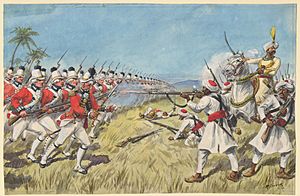Siege of Cuddalore facts for kids
Quick facts for kids Siege of Cuddalore |
|||||||
|---|---|---|---|---|---|---|---|
| Part of the Second Anglo-Mysore War | |||||||
 Drawing of the action by Richard Simkin, 1890 |
|||||||
|
|||||||
| Belligerents | |||||||
|
|
|||||||
| Commanders and leaders | |||||||
| Strength | |||||||
| 12,000 | 9,000 | ||||||
| Casualties and losses | |||||||
| 1,500 | 1,100 | ||||||
The Siege of Cuddalore was a major event during the Second Anglo-Mysore War. It was a fight where British troops tried to capture the fortress of Cuddalore. Inside the fort, a combined force of French and Mysorean soldiers defended it. The siege ended when France and Britain agreed to a peace treaty.
Contents
What Was the Siege of Cuddalore?
The Siege of Cuddalore was a military operation in 1783. British forces tried to take control of the important fortress of Cuddalore. This fortress was located in what is now southeastern India. The defenders were a mix of French and Mysorean soldiers.
The British army was led by Major-General James Stuart. They arrived outside Cuddalore on June 7, 1783. Stuart's army included soldiers from the 73rd and 78th Highlanders. It also had the 101st regiment and many Sepoys, who were Indian soldiers. Later, two Hanoverian regiments joined them. These German soldiers were commanded by Colonel Christoph August von Wangenheim.
The French and Mysorean defenders were led by Marquis de Bussy-Castelnau. They set up their defenses about half a mile (0.8 km) in front of the fort.
The Attack on the Redoubt
On June 13, General Stuart decided to attack a small fort-like structure called a redoubt. This redoubt was in front of the main Cuddalore fort. The British hoped this attack would put more pressure on the defenders.
The attack began early in the morning, around 4 AM. This gave the British a surprise advantage. After fierce fighting, the French and Mysorean forces were pushed back. They lost their main defensive positions. A final counterattack by the defenders was also stopped. Both sides then agreed to a temporary stop in fighting.
The battle was costly for both sides. The French and Mysoreans lost nearly 500 soldiers. Stuart's forces also suffered greatly, with over 900 British, Hanoverian, and Sepoy soldiers killed or wounded. Even though his army was weakened, Stuart continued to surround Cuddalore. He also prepared for more help to arrive by sea.
The British army needed support from their navy. However, on June 20, a French fleet arrived. This fleet was led by Bailli de Suffren. The French fleet met the British fleet in a naval battle. The British fleet was forced to leave and sail to Madras.
With the British navy gone, Suffren had an advantage. He was able to land 2,400 more soldiers, marines, and sailors. These new troops joined de Bussy's defenders inside Cuddalore. This made the two armies almost equal in size.
French Counterattack Repelled
With new soldiers, de Bussy decided to launch a surprise attack. This attack, called a sortie, aimed to break the British siege lines. General Stuart knew about the new French troops. He prepared his forces for a big attack.
On June 25, the French made several attempts to break through the British lines. They had some early success. But the French could not push their advantage. Stuart's forces fought back hard. They managed to stop all the French attacks. De Bussy called off the attack when he realized they were not making progress. The French had lost many soldiers for no gain. This was a big missed chance for de Bussy to defeat the British.
The French soldiers' spirits dropped after this failure. They had lost their advantage in numbers. The balance of power had shifted back to the British. The British had only 23 men killed or wounded. The French attacking force lost 450 killed or wounded. Another 150 French soldiers were taken prisoner. Among the captured was a young sergeant named Jean Bernadotte. He had landed with Suffren's fleet. Bernadotte later became a famous general and eventually the King of Sweden.
The End of the Siege
The siege continued for five more days. Both armies were getting weaker. Many soldiers were falling sick or getting wounded. Stuart's forces were suffering more than de Bussy's. Stuart even wrote to the government in Madras, saying his army felt abandoned.
De Bussy planned another attack. This time, he wanted to go around the British lines to attack their main camp. However, this attack never happened. On June 30, a British ship arrived with important news. France and Britain had agreed to a preliminary peace treaty.
What Happened Next?
On July 2, Britain and France officially stopped fighting. However, the war between Mysore and Britain continued. In the Peace of Paris (1783) treaty, Cuddalore was given back to Great Britain. In return, the British gave back Pondicherry and Mahé. These were two French territories that Britain had captured earlier.
Fighting between the British and Mysoreans went on until March 1784. That's when the Treaty of Mangalore was signed, finally ending the war.


